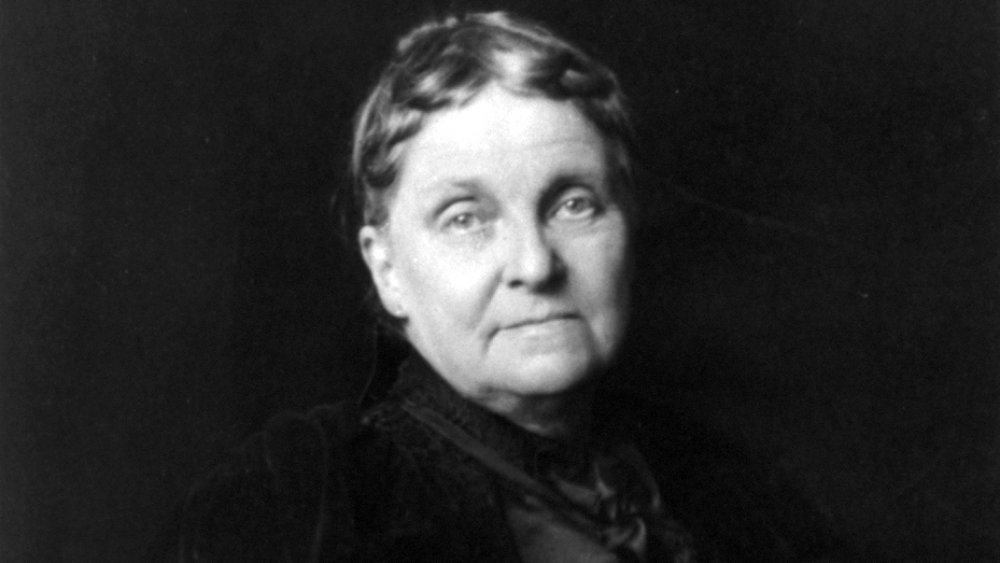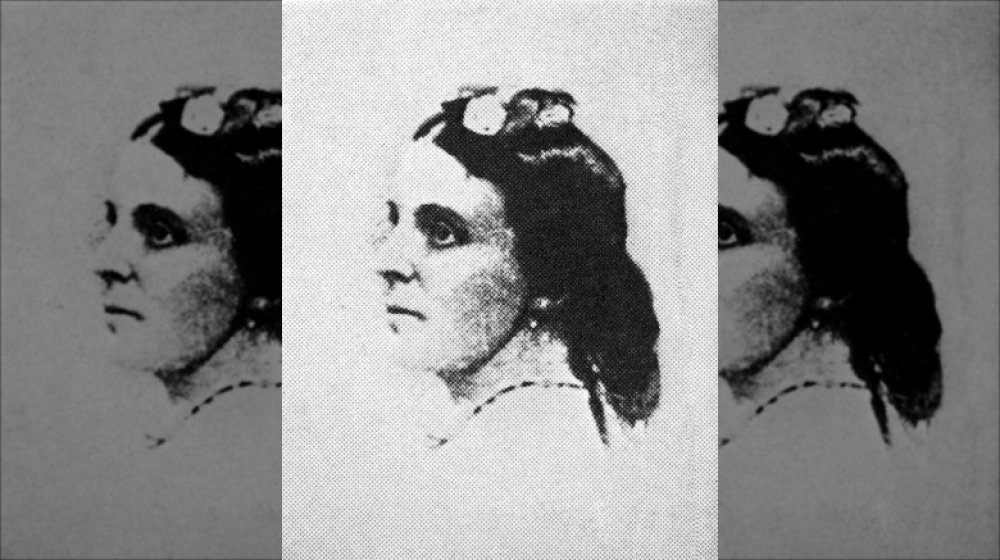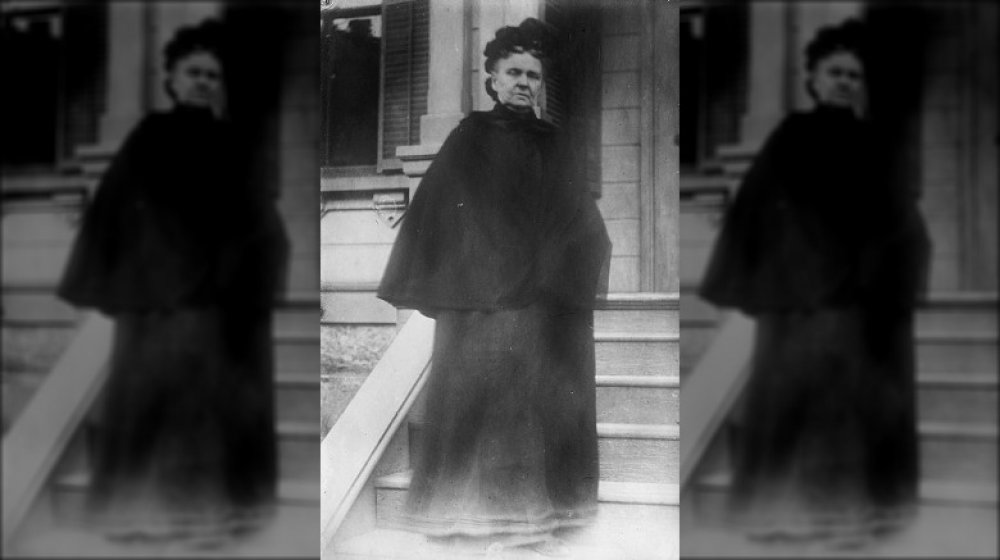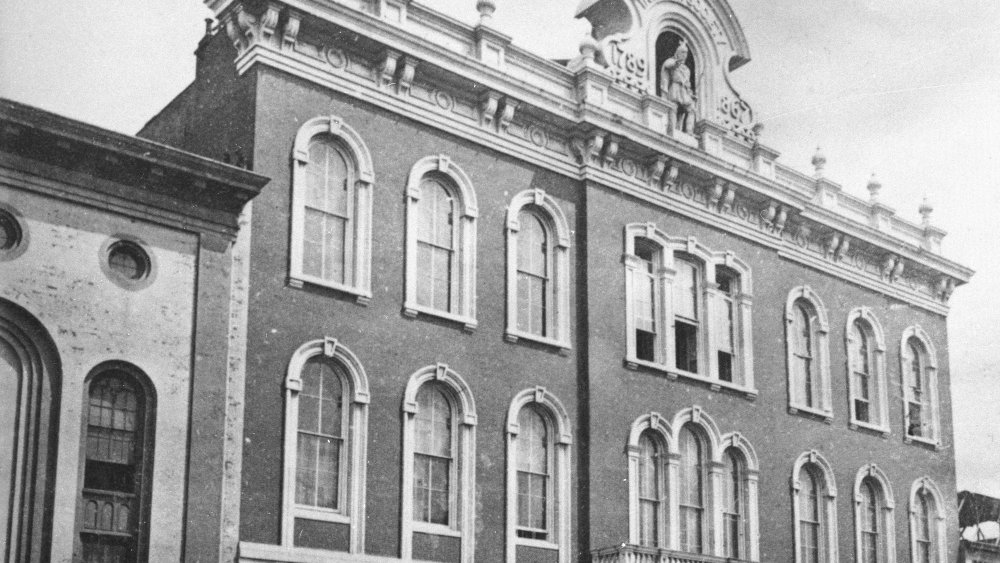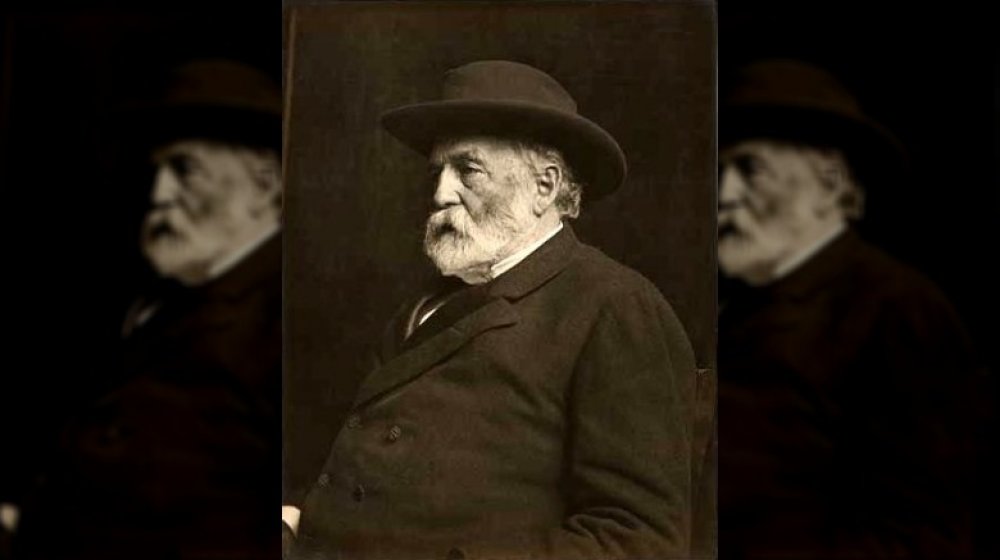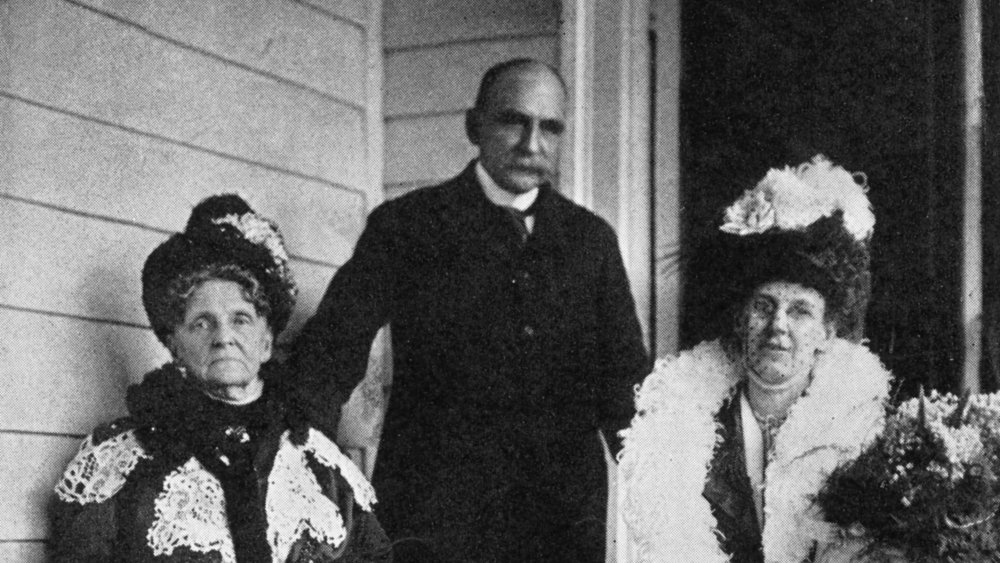The Messed Up Truth Of Hetty Green, America's Greatest Miser
Henrietta Howland Robinson Green, aka Hetty Green, holds the record for being the biggest miser who ever lived. Born in 1834, she barely spent any cash on anything (including clothing and food), she dodged taxes, and collected interest on everything she lent out. In other words, Green was absolutely ruthless when it came to money.
But she was also the richest woman in America for most of its history. In the Industrial Age, an era famous for powerful men like the Rockefellers, she was often the sole woman in the room. And she could do more than hold her own, as she was often the one saving everyone's rear ends while things came crashing down. But Green didn't do any of this without making a few enemies. There's a reason she's called the "Witch of Wall Street," after all. But she's definitely a character worth remembering. A real-life Ebeneezer Scrooge, Hetty Green got ridiculously rich and infuriated people with her miserly ways, and this is her messed up story.
Hetty Green came from money
Like a lot of billionaires you've probably never heard of, Hetty Green initially received money as an heiress. She was the only child of a Quaker family that had made a fortune in shipping and whaling. You know the oil lamps of the Victorian period? Her family hunted the whales that provided the oil.
But being born rich didn't mean that Green was spoiled. According to Smithsonian, she was educated about money from the time she was very young. Her grandpa had her read aloud the financial news to him, and author Janet Wallach (via the New York Post) suggests that money was how the family communicated love to each other. Green's father took her to important meetings at their businesses at the docks, and crazier still, Green had a bank account at age eight, and she'd taken over accounting for the family business by age 13.
Green was a rough and tumble kid, but she was definitely expected to become a lady as she grew older. However, she was officially hooked on the independence money could give her. And from a very early age, she started getting frugal with her pocketbook. For example, her aunt, Sylvia Howland, gave her $1200 to buy new clothes for her coming out party, and she ended up spending only $200. The rest went toward government bonds.
She did shady things to get an inheritance
Hetty Green's interest in money definitely made her unusual for her time. But it didn't make her immune to the sexism around women having money of their own. For example, things first started getting tough when Green's father died when she was 30. Her father left her around $7 million, but it was all put into a trust that other people would manage. Things got even more complicated when her Aunt Sylvia died in 1868, as her will shared her $2 million with doctors, caretakers, distant relatives, and charitable organizations.
All of this felt deeply unfair to Green ... although she fought back in some rather illegal ways. According to the New York Post, after her father's death, she tried and failed to bribe the executors of her dad's will (presumably to unlock the trust and allow her more control). And when her aunt kicked the bucket, Green presented what she claimed was the real and true will of her aunt, one that named Green as the main beneficiary. However, the court ruled that it was a complete forgery. It probably didn't help her image any when Green pushed a housekeeper down some stairs because she was trying to get some of Aunt Sylvia's money (via The Washington Post). It was probably thanks to all this hassle that Green became so determined to hang onto all the cash she did have.
She got rich from 'boring' investments
Unlike venture capitalists and tech giants, Green wasn't trying to make money by investing in sexy companies. Instead, she wanted to play the long game and get rich off steady investments. Every cent she earned from her locked trust was re-invested, earning money that no one would control but her.
Green was never interested in quick profits and would never think of borrowing money just for the sake of buy something she wanted. She liked real estate and bonds, both investments that take time and maturity. But she also wasn't too attached to sell off anything that could turn a profit. When asked how women should invest, even if they just had a little money, she replied, "I regard real estate investments as the safest means of using idle money. ... Let a woman watch and see in which direction a city is going to develop and buy there."
Green was also in favor of women getting involved in finance but not on Wall Street, where she rarely invested because it was so mercurial. She also considered it "no place for a lady," for some reason.
She married late (for her time)
Hetty Green was actually considered very pretty and charming as a young woman. She once met the Prince of Wales, introducing herself as the "Princess of Wales." He ended up dancing with her twice that night, which was Victorian Age code for being really into someone. Newspapers at the time called her "a belle of New York society, ardently sought by numerous lovers not only for her wealth but also for her beauty."
She eventually settled down with Edward Henry Green when she was 33. Always thinking ahead, she arranged for a prenuptial agreement, and according to the Library of Congress, her husband willingly agreed to give up all rights to her money. He was already rich on his own and would work in banking through their marriage. However, there were nasty rumors about their relationship, like that her husband had an allowance. That one wasn't true, but the couple did end up separating because Edward just wasn't that good with money (she had to bail him out financially more than once). Nevertheless, they stayed good friends, and Green started wearing her signature black dresses after Edward died.
Hetty Green was famously cheap
Hetty Green was a lady during the Gilded Age, a time of great luxury and glamour. If people had money, they were expected to flaunt it and not be afraid to spend it. So Green definitely made a splash when she didn't seem to care about looking like a rich heiress. In fact, as she grew older, she would only wash the hems of her dresses so she wouldn't have to pay so much for soap.
Her famous stinginess was epitomized by her oatmeal lunches. She would eat it dry or perhaps warmed over a radiator. She liked simple food in general, though there's probably not a person today that would say no to a Gilded Age ham sandwich and a 15-cent pie. Of course, Green preferred to carry around graham crackers so she wouldn't have to spend any money. And Pinterest would probably love her decorating hack of displaying fake roses made from dyed chicken feathers.
Hetty Green's son lost a leg because she wouldn't pay for decent health care
Unfortunately, Green's thrift could sometimes get in the way of her own happiness. For example, she refused an operation to remove a hernia because it would cost $150. It's said she wouldn't use hot water or heat in the winter. And for her son Ned, her desire to pinch pennies would cost him big time.
So here's how it all went down. Ned was sledding outside when he injured his leg, and the boy desperately needed medical aid. Afraid of being overcharged, Green decided to take him to a free clinic. But once the doctor realized he was treating the wealthiest woman in America, he kicked the family out. Soon after, gangrene set it, and as a result, Ned had to have his leg amputated. For the rest of his life, the guy had to get around on a fake limb made of cork.
By all accounts, Green wasn't a cold mother. She loved her kids, and she groomed her son to take over her fortune. In fact, all her money went to her children who, according to Forbes, were much more eager to spend the gobs of money she'd worked so hard to save. Her daughter Sylvia gave millions to charity, and Ned bought a bunch of mansions. But he probably earned them after giving up a leg to inherit so much cash.
America's greatest miser was really cheap when it came to office space
When it came to saving money, Green was an absolute pro. She avoided paying taxes as much as possible, especially property tax. So how exactly did she do that? Well, instead of renting out an office like a normal person, she set up shop at Chemical Bank. The woman had her own free office there, which is ironic since the place was a state bank at the time, so New York was literally paying for Hetty Green to do her job.
She also moved between cheap boarding houses extensively during her lifetime, never staying long enough to establish a permanent residence. This meant a very unstable life for her children, and she herself hated sleeping in unfamiliar places. But this strategy kept her from paying into the government's coffers, and it came with an extra perk. She could also avoid reporters. Hetty was interviewed by the press a fair amount during this time. But she wasn't naturally as gregarious as the other millionaires and robber barons of her era. She was proud of not being a snob, which may have caused friction between herself and the other richest people of the era.
Her sworn enemy was Collis P. Huntington
At first, Green and Collis P. Huntington seem like they should've been friends. As Connecticut History details, Huntington came from a very poor background and made his fortune through saving and selling necessary goods at the right moment. He eventually grew rich through his construction of the Central Pacific Railroad and its associated businesses.
However, their relationship was one of mutual disgust. Granted, Green invested in railroads and considered them better than similar investments of the time, such as mines and factories. But Huntington disapproved of how often she loaned out money and collected interest, calling her "nothing more than a glorified pawnbroker." Plus, Green had principles that kept her from abusing the poor, and she sided with protesting railroad workers in 1895. She even went so far as to suggest that Huntington should be arrested instead of the protesters.
But at the heart of their feud was business. Erenow, quoting Hetty: The Genius and Madness of America's First Female Tycoon, details that Green hated how Huntington had mismanaged two railroads, causing an investment firm to fail. This had cost Hetty a lot of money. Huntington was also acting like he could do whatever he wanted regardless of what the shareholders wanted. In revenge, she bought up shares in Huntington's company and refused to vote on a major merger. Her dilly-dallying — and eventually withdrawing her "yes" vote — caused the stock to drop by $30 per share. She later bought two railroads just to mess with him.
Green wasn't afraid to loan money during hard times
Hetty Green was considered an anomaly in finance because she was a woman. But on top of that, some of her investments were perceived as heartless or predatory by her colleagues (and the public). And when you combine that with her thrifty nature, it's easy to see how she got her witchy reputation.
Green saved money so she could invest at the right times, buying when stocks were cheap so she could sell them later. But that also applied to buying cheap property. Green wasn't afraid to purchase land in places that had suffered earthquakes, fires, or other disasters. And it wasn't to do locals a favor, as she'd sell the land back when people offered the right price for it. It was the same with stocks and shares she would acquire during a financial crisis.
It wasn't in Green's nature at all to grant favors with money. When she lent money out, she charged interest. She wasn't afraid to lend money to people or even institutions like banks, according to Mental Floss. But if you couldn't pay your debts and you put your real estate up as collateral, she wouldn't hesitate to take your property and sell it later for a profit. Even banks and cities feared this woman, as she often held their futures in the palm of her hand.
She bailed out New York City three times
Green would die in 1917, before the Great Depression hit America. But when she was alive, there was a small (but still scary) crisis in 1907. Green immediately started buying up cheap property and plummeting stocks so she could resell them when times turned around. But her city would need her checkbook long before things got back to normal.
As a result, Green lent the city of New York over $1 million to keep the city from going bankrupt. In return, she received short-term revenue bonds. According to Investopedia, these bonds are issued by cities or municipalities in units of $5000, and they mature in 20-30 years. This means that Green could cash the bonds in a few decades and earn interest on top of what she gave — all paid for by the subway fares, toll roads, and other cash handed over the citizens of New York.
This was a serious power move, but Green had already done this twice before. Morningstar, Inc. reported that she lent the city $1 million in 1898 and $1.5 million in 1901. New York wasn't even the only city she helped, as she bought out all the revenue bonds issued by the city of Tucson, Arizona, in 1900 when they needed a new water and sewage system.
America's greatest miser died a billionaire
In 1916, The New York Times reported that Green suffered a series of strokes while staying in her son's house. She was 81, and she allegedly died after ranting about the greatness of skim milk. That's the best way for a cheap person to go, really. But how much money had she earned when she finally kicked the bucket?
Well, sources at the time put her at $100 million. That's the equivalent of $4.5 billion in 2016 money. All that from less than $10 million she inherited that was distributed to her when someone else felt like it. Beyond the money, Green's impressive wealth was documented in how many properties she procured. Morningstar, Inc asserts that Green owned over 6,000 assets. This means buildings, land, churches, and even cemeteries, all of which she bought at some point with the aim of selling them. Or in some cases, she collected rent on her property, and she allegedly earned $40,000 a month just from the properties she owned in Chicago.
Hetty Green could be very generous to those in need
Hetty Green has been painted as a great villain of history, largely thanks to articles in the 1920s that were amazed at her thrift. But even though she was America's greatest miser, she wasn't all about deprivation. She just rarely sought credit or attention for her charitable contributions. As it turns out, Green donated money to Johns Hopkins Medical School on the condition that they start admitting women as students. John Hopkins Magazine reports that the school started letting females attend in 1889, and perhaps it was because of her donation.
In her personal life, Green's spending habits seemed to ease up over time. For example, she encouraged her daughter not to marry for money. And when her daughter finally got engaged, Green actually wore a nice dress and rented a suite to celebrate the event at the Plaza Hotel. Plus — not counting the incident with the amputated leg — she was incredibly protective of her kids, and she once pulled a gun on someone who threatened her son.
Overall, Green seemed happy to live her life how she wanted, and she didn't seem to care about her reputation as a miser. At one point, she told a reporter, "I am a Quaker, and I am trying to live up to the tenets of that faith. That is why I dress plainly and live quietly. No other kind of life would please me."
